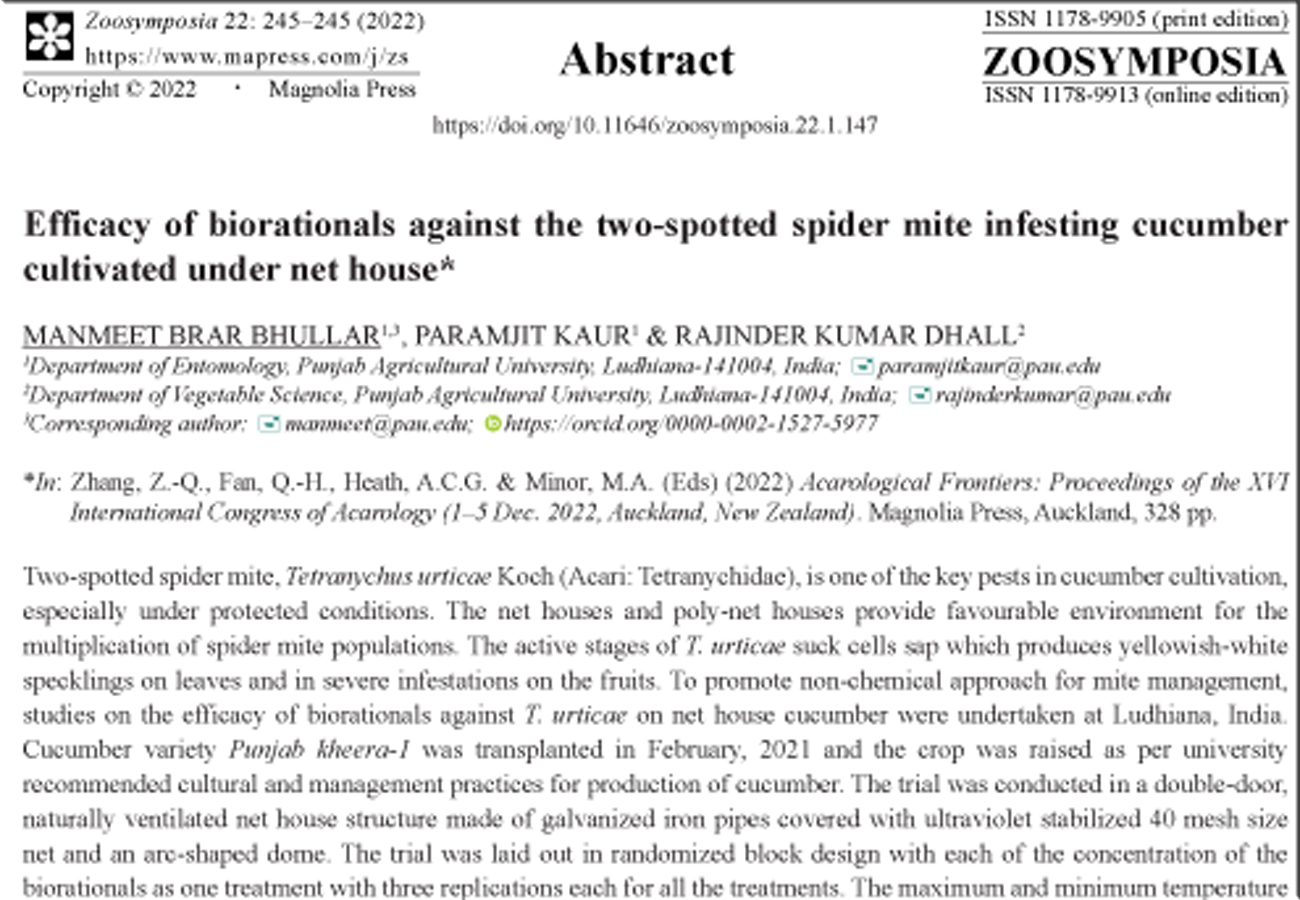Abstract
Two-spotted spider mite, Tetranychus urticae Koch (Acari: Tetranychidae), is one of the key pests in cucumber cultivation, especially under protected conditions. The net houses and poly-net houses provide favourable environment for the multiplication of spider mite populations. The active stages of T. urticae suck cells sap which produces yellowish-white specklings on leaves and in severe infestations on the fruits. To promote non-chemical approach for mite management, studies on the efficacy of biorationals against T. urticae on net house cucumber were undertaken at Ludhiana, India. Cucumber variety Punjab kheera-1 was transplanted in February, 2021 and the crop was raised as per university recommended cultural and management practices for production of cucumber. The trial was conducted in a double-door, naturally ventilated net house structure made of galvanized iron pipes covered with ultraviolet stabilized 40 mesh size net and an arc-shaped dome. The trial was laid out in randomized block design with each of the concentration of the biorationals as one treatment with three replications each for all the treatments. The maximum and minimum temperature varied from 31oC to 36oC and 16oC to 18oC, respectively, while morning and evening relative humidity varied from 68 to 82% and 20 to 26 %, respectively during this period. There were 10 plants per plot in each treatment, separated by a distance of 50cm between 2 plots to avoid chemical interference owing to drift to adjacent treatments. For foliar applications of different treatments, a battery-operated knapsack sprayer fitted with hollow cone nozzle (40 PSI pressure) was used. Different biorationals including indigeneous ‘gurukul’ products as given in Palekar’s model of organic farming i.e. brahamastra (20 litres cow urine, 2 kg each of neem, mango, guava, castor leaves boiled in 100 litres of water and then filtered), neemastra (5 litres cow urine, 2 kg cow dung, 5 kg neem leaves boiled in 100 litres of water and then filtered), agniastra (20 litres cow urine, 5 kg neem leaves, 500g each of chilli and garlic fruits boiled in 100 litres of water and then filtered), all at the dose of 10, 20 and 30 ml/litre and botanicals viz. PAU homemade neem (Azadirachta indica) extract (PAUHMNE) @ 12, 14, 16 ml/litre, dried neem fruit powder extract (DNFPE) @ 3, 4, and 5%, PAU homemade dharek (Melia azaderach) extract (PAUHMDE) @ 12, 14, 16 ml/litre, dried dharek fruit powder extract (DDFPE) @ 3, 4 and 5%, and water spray along with untreated control were evaluated. The different indigenous products and botanicals were prepared freshly. Two sprays of the treatments were given at weekly interval, with the first spray at the appearance of 20–25 % mite infestation on plants. Observations were recorded from randomly selected three leaves each from top, middle and bottom canopies. The number of active stages of mites were recorded before the treatment, 1, 3, 5 and 7 days after each spray (DASI and DASII). The data were subjected to square root transformation and analyzed statistically following Analysis of Variance. The results were interpreted at 5 per cent level of significance using Tukey’s test. The number of mites before treatment ranged from 31.00 to 36.67 mites/ 2 cm leaf area in different treatments. Significantly lower mean number of mites was observed in agniastra (9.78), PAU HMDE (9.67), neemastra (10.67), DNFPE (11.47), DDFPE (12.22), brahamastra (12.67) and PAU HNE (13.11) at highest doses after 3 DASI and 5 DASI, compared to the untreated control (35.66 and 36.22). After the second spray of the biorationals, mean number of mites in PAU HNE (14.33), neemastra (14.67), PAU HMDE (15.17), DNFPE (15.33), DDFPE (16.17), agniastra (16.50), brahamastra (18.83) were observed at highest doses after 3 DASII and 5 DASII. No phytotoxicity was observed in any treatment. Seeing the overall results, it can be concluded that these botanicals and indigenous products can be incorporated in integrated mite management programme which will help in reducing the pesticide load and promoting organic cultivation of the vegetable crops.
References
-


